Warm, freshly baked pita bread straight from your oven—can you imagine anything better? This easy homemade pita bread recipe is ready in under an hour and delivers soft, chewy pitas that are perfect for everything from sandwiches to dipping. With just a few simple ingredients, you’ll have authentic, delicious pita bread that rivals anything from the bakery.
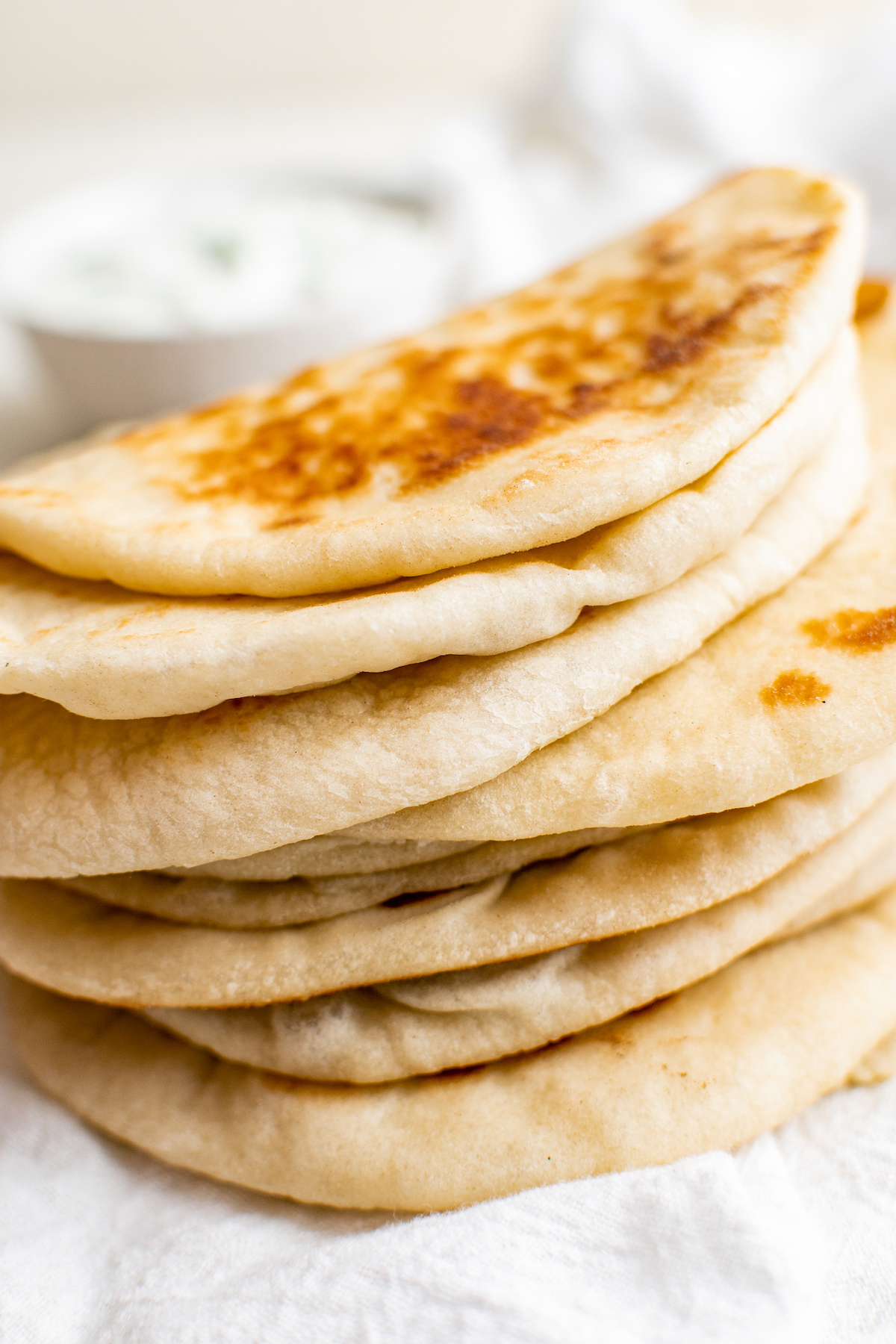
Want to save this recipe?
Why I Love This Homemade Pita Bread Recipe
Living in Tampa, we have a large Greek community and I used to just pick up a batch of pita from the local shops. It wasn’t until I tried making it from scratch that I truly fell in love. There’s something so satisfying about watching the dough puff up on the hot skillet, knowing that soon I’ll have warm, fresh pitas to slather with my favorite homemade tzatziki sauce! Here’s why I think you will love this easy pita bread recipe too:
- Easy to Make: With just 6 simple ingredients and easy to follow steps, you’ll have fresh, homemade pita bread ready in no time. No special equipment needed!
- Perfect Texture: They’re so soft, chewy and tender, but with a crispy, golden exterior thanks to cooking on a hot skillet instead of in the oven.
- Versatile: Use this pita bread for sandwiches, wraps for falafel, dipping it in hummus, or as a side with my favorite juicy chicken souvlaki!
- Budget-Friendly: Making your own pita bread at home is not only delicious but also a cost-effective alternative to store-bought bread.
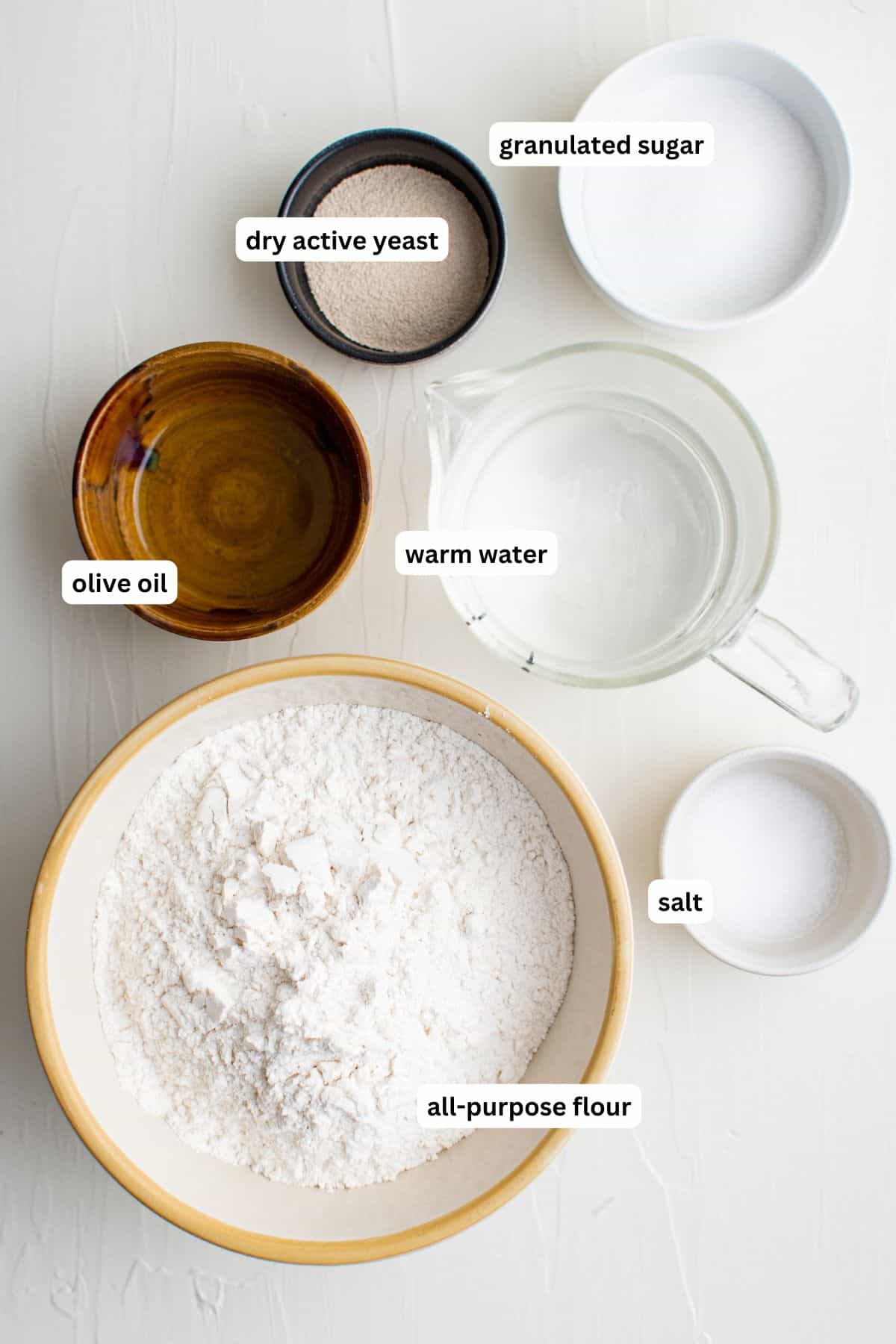
Key Ingredients
Below you will find helpful notes for key ingredients used to make this easy pita bread recipe. Scroll down to the recipe card below for the full ingredient list and exact amounts!
- Flour: I generally use all-purpose flour, but you could try this recipe with whole wheat flour or a mix of the two.
- Yeast: You’ll need active dry yeast so that the dough can rise. I have tested this recipe with instant yeast, but a few times my dough did not rise as much. If you choose to use instant yeast, you do not have to proof it and can add it directly to the flour.
- Sugar: I used granulated sugar, but any similar sugar will work. You only need a little!
- Water: Your water should be warm so that the yeast activates, but not hot.
- Olive Oil: I like to stick to extra virgin olive oil, but other mild flavored cooking oils can be used instead.
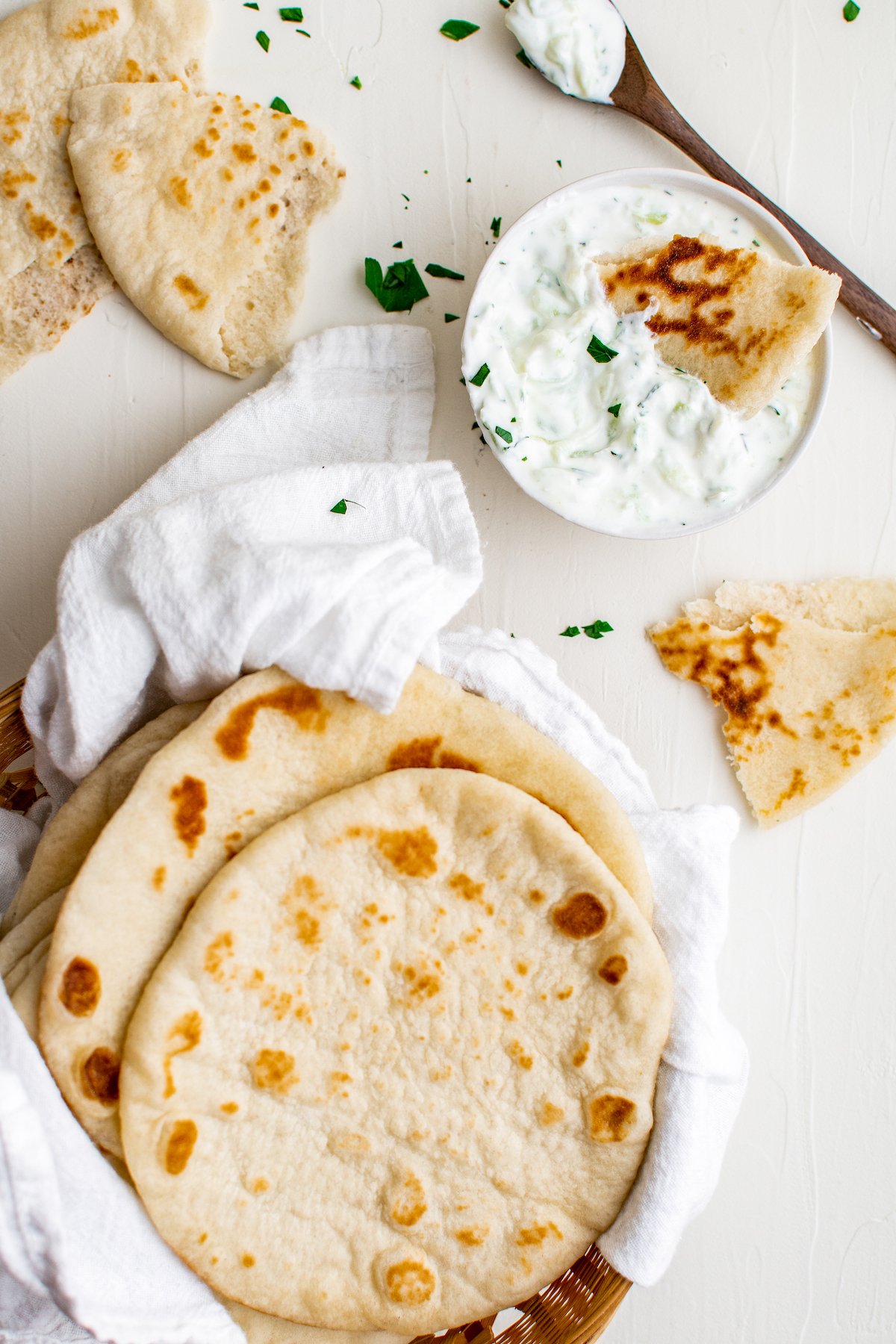
How to Make Pita Bread
While the ingredient list for pita loaves is pretty short, the process for making the actual bread is a little longer. But it’s not that difficult, so don’t let the length scare you away! You’ll be through these simple step-by-step instructions in no time! Below is a quick recipe overview, but please scroll to the recipe card at the bottom of this post for full instructions and to watch the step-by-step video.
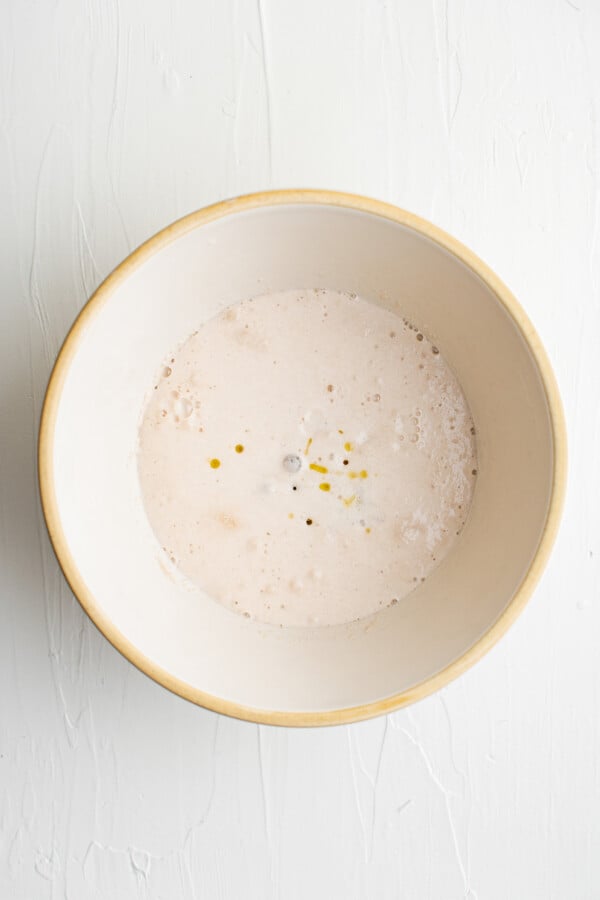
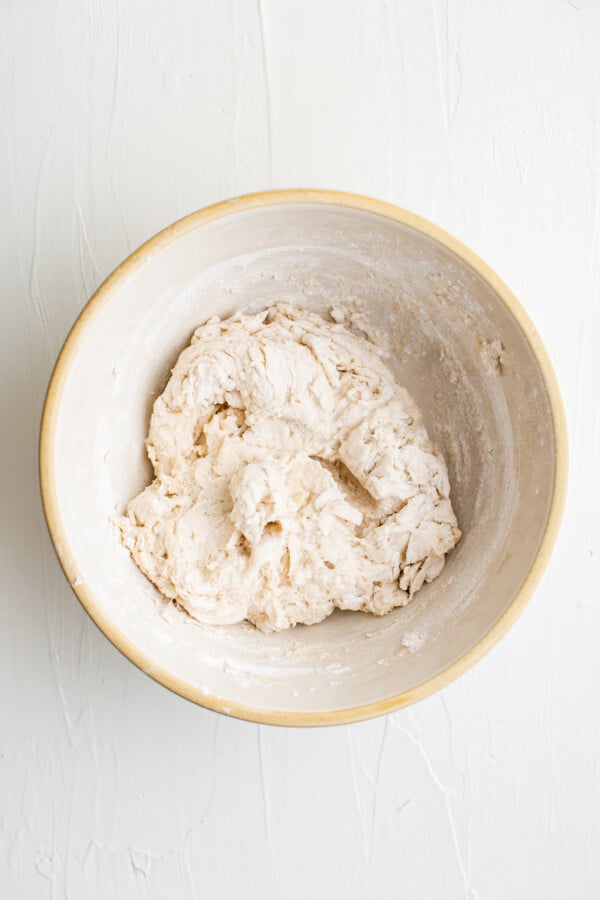
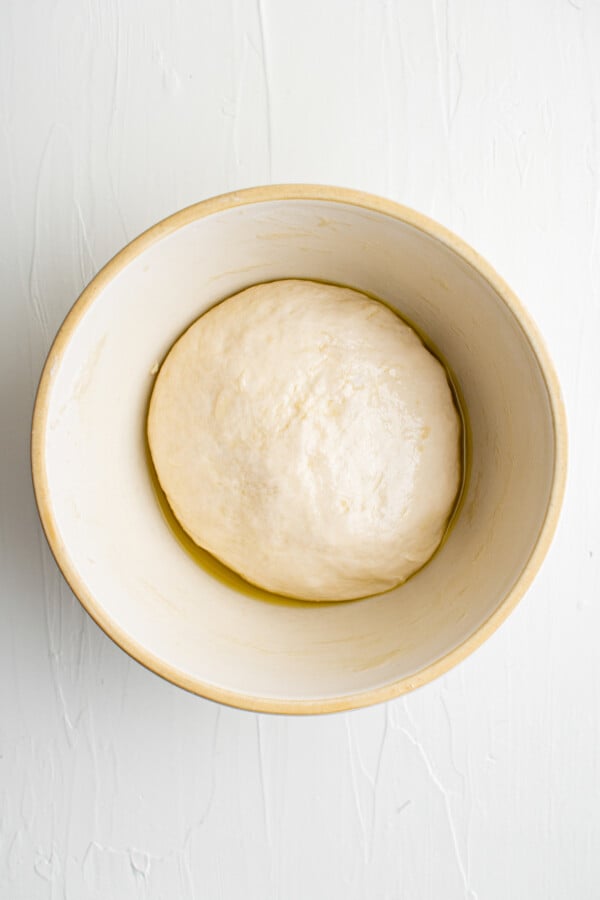
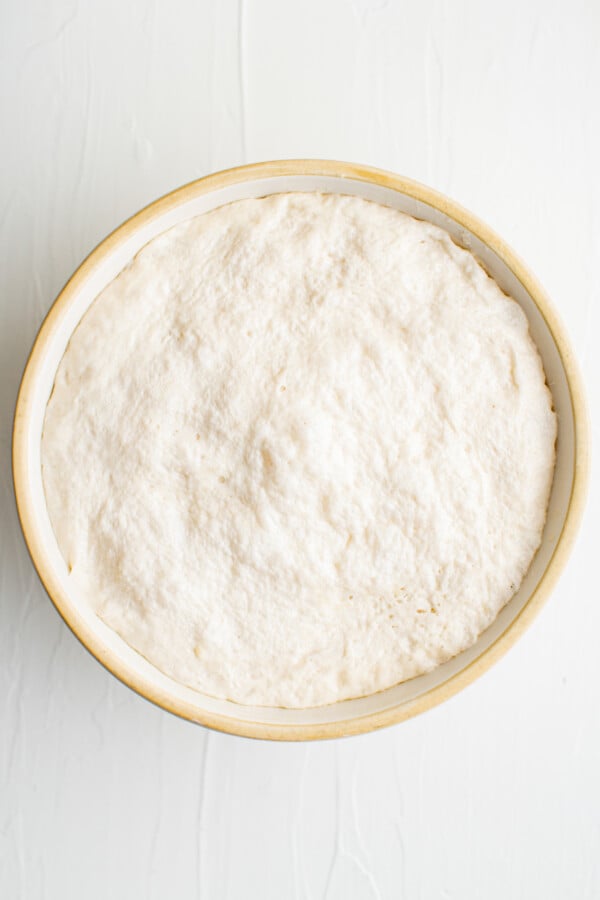
- Activate the Yeast: Whisk together the sugar and yeast, then stir in the warm water. Let the yeast rest for 5 minutes, until frothy.
- Make the Dough: Add the salt and olive oil, and then using a wooden spoon, add 2 ½ cups of flour. Continue stirring and add a tablespoon of flour at a time until the dough starts to pull away from the sides.
- Knead the Dough: Turn the dough out onto a counter dusted with flour and knead it for 15 minutes. If you have a stand mixer with a kneading attachment then you’ll only need to knead for 10 minutes. Tuck in the edges of the dough then coat the same bowl with olive oil that you used before. Add the dough and roll it around in the bowl to coat it in the olive oil.
- Let the Dough Rise: Cover the bowl with plastic wrap or a thin towel. Let dough rise in a warm area, for about an hour, until it has doubled in size.
- Separate the Dough: Remove dough from the bowl and cut it into 10 equal pieces. Tuck the edges of each piece to form balls, then cover them with a towel and let them rest for 20 minutes.

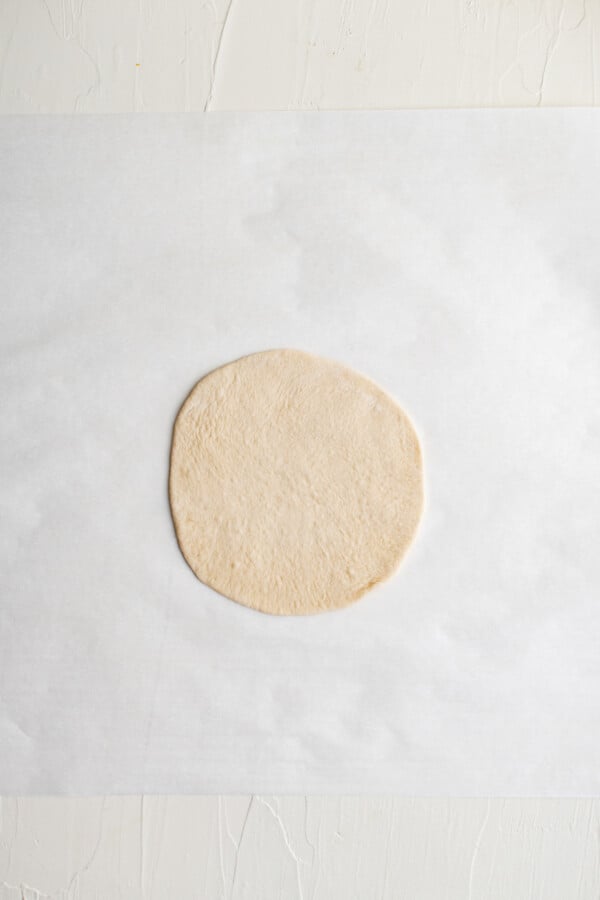
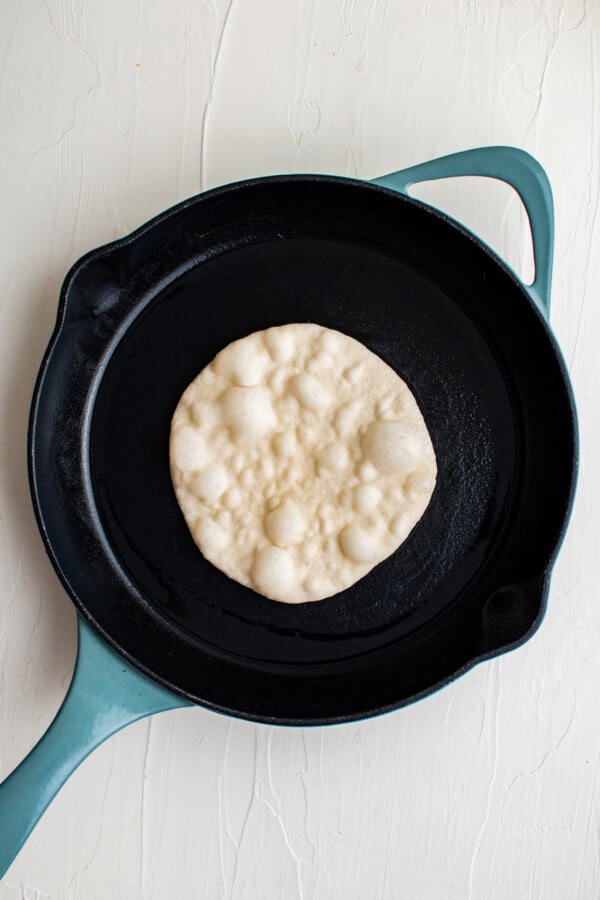
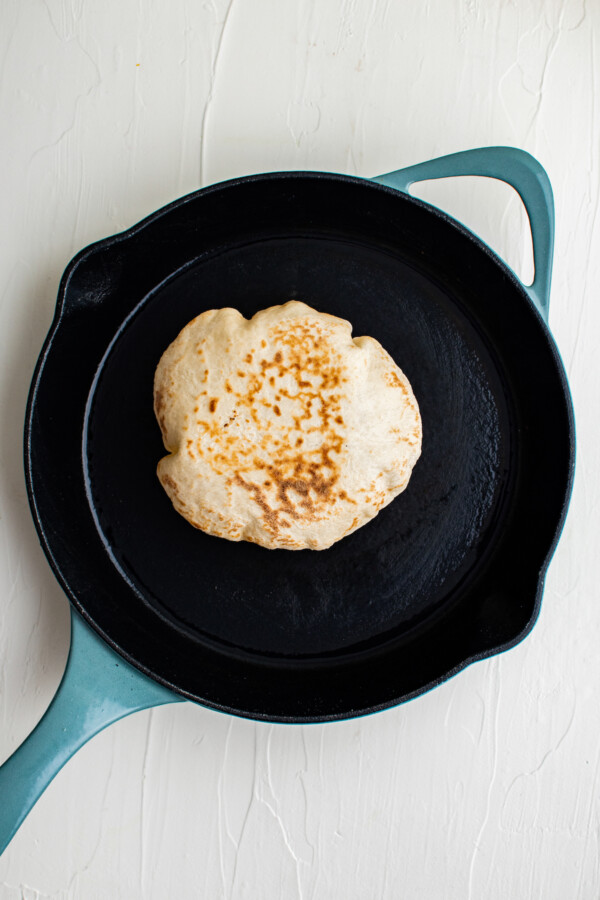
- Roll Out the Dough: Roll dough balls out into a ¼ inch thick disk that’s about 6 inches across. (These do not have to be perfect, just form the best circle or oval that you can.)
- Heat a Skillet: Let the uncooked pita rest for five minutes as you heat a large cast iron skillet over medium heat. Lightly coat the pan with olive oil then place one of the uncooked pitas in the pan.
- Cook the Pita: Cook for about 30 seconds, until you see 4 to 5 bubbles start to form, then flip the pita over and cook for another 30 seconds. Then flip it again and cook for 1 minute and allow the bread to puff up. Remove it from the pan and cover with a towel to trap the steam and keep the pitas soft. Not all of the pitas will puff up, but they should all form large bubbles.
- Serve and enjoy: Wrap cooked pita with a tea towel or foil to keep warm while you finish cooking all of the pita. Enjoy it served fresh and warm!
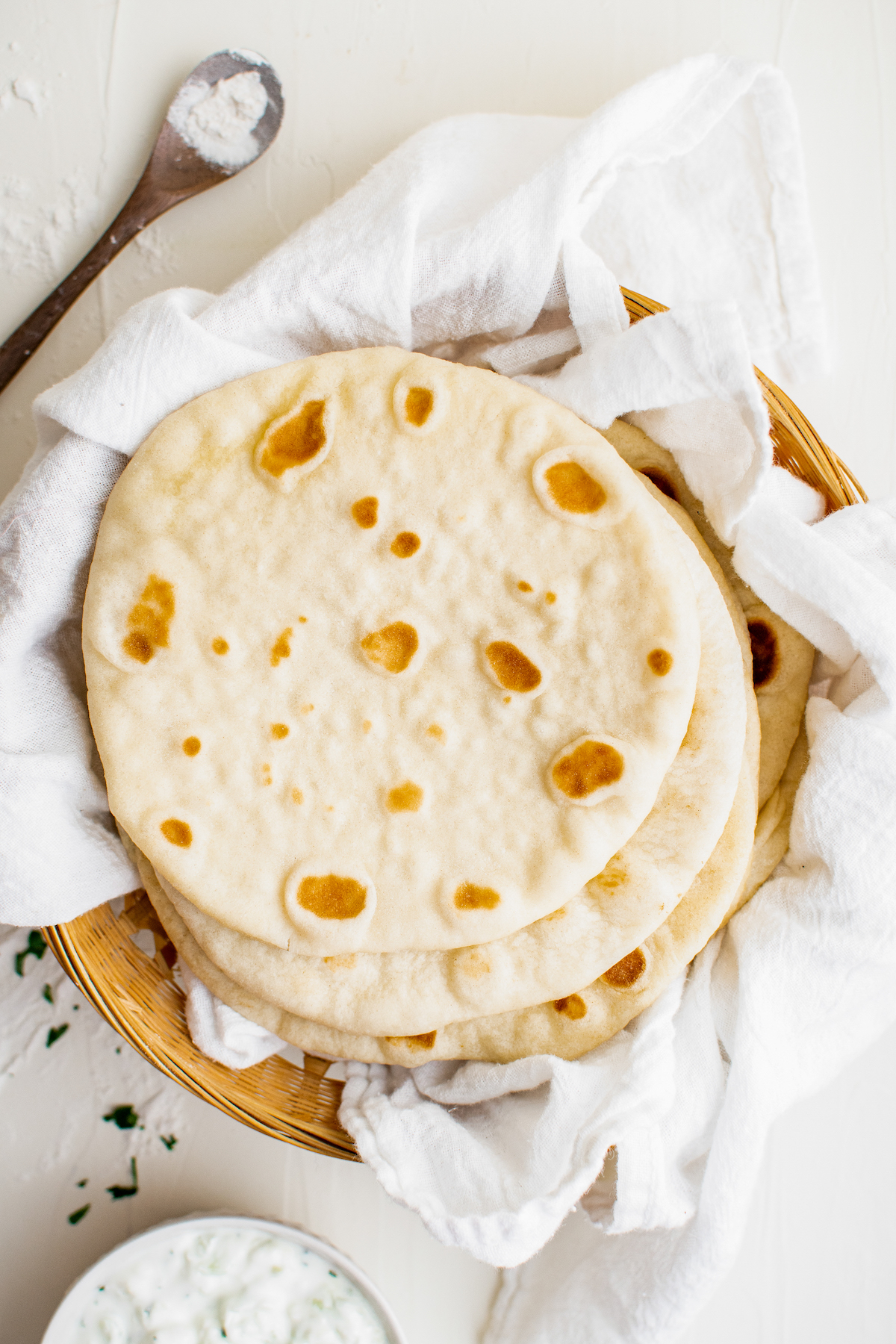
Chef’s Tips and Variations
- Can I Use a Stand Mixer? Sure! When you’re combining all of the ingredients, use a stand mixer if you would like to. I prefer to knead this bread with my hands because I think the texture is best when I do it that way, but it’s totally up to you.
- Let the Dough Rise in a Warm Area: You don’t want it to be surrounded by heat, but the dough should be kept in relative warmth if you want it to truly double in size. Avoid cool temperatures too – this could slow the activity of the yeast.
- Use Minimal Flour When Kneading and Shaping: Add a dusting of flour if the dough gets too sticky to handle, but don’t overdo it or the dough will become hard. The dough should be tacky, but not too sticky to knead.
- Add Flavor to the Dough: For a twist, try adding garlic powder, za’atar, Greek seasoning, or dried herbs to the dough for extra flavor.
- Use a Pizza Stone in Oven: Heat a pizza stone, or a large cast iron skillet, in the oven at 475°F. Coat pizza stone in olive oil and add as many pitas as you can fit without overlapping. Bake for 2 minutes on one side, then flip pita over to bake for 1 minute more on the other side.
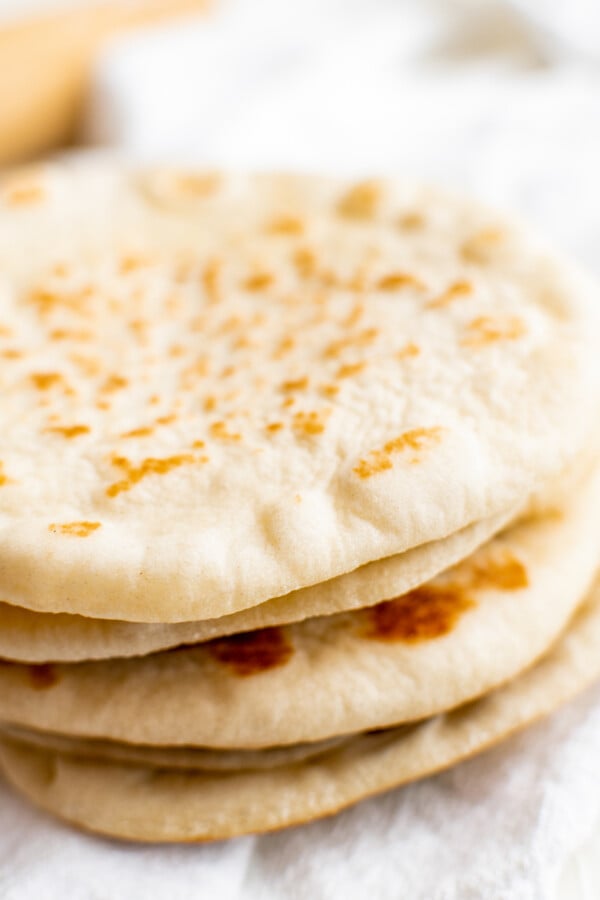
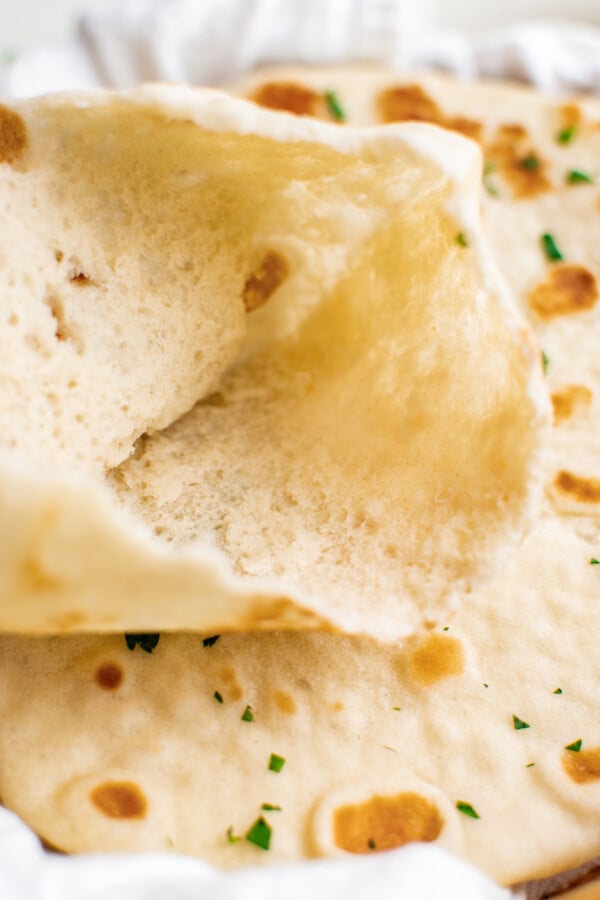
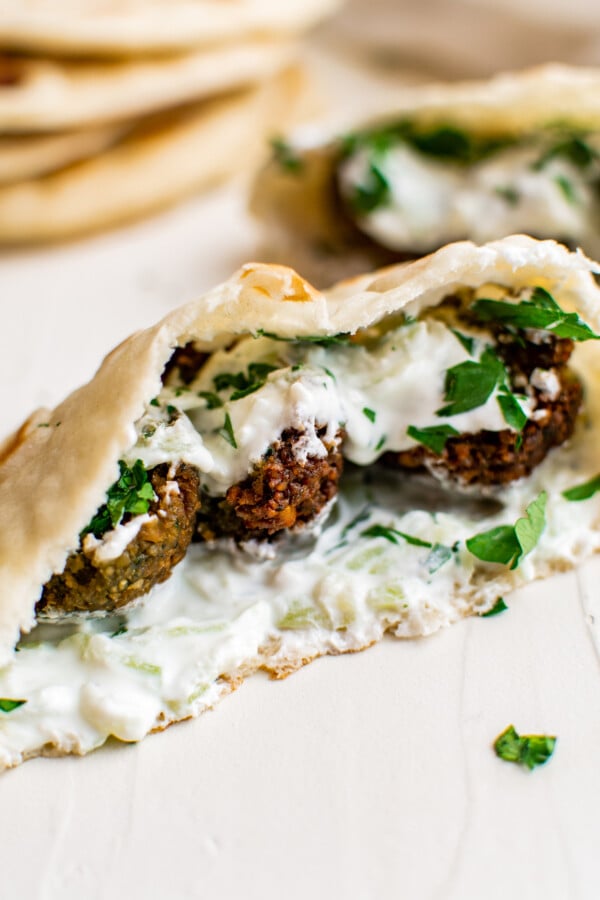
Serving Suggestions
Pita bread can be served with practically anything – it’s very versatile. While I enjoy eating it just as it is, here are a some pairing ideas:
- For Dipping: The perfect appetizer! Tear off hunks of pita bread, and dip them in my creamy tzatziki sauce or hummus! I also have a great sweet potato hummus recipe!
- With A Salad: We love it alongside our favorite green Greek salad with this flavorful Greek salad dressing.
- Stuff It: One of the best things to stuff your pita bread with is falafel. You also can’t go wrong with these Greek turkey burgers or Greek chicken meatballs!
- Souvlaki: Serve your pita with juicy and flavorful chicken souvlaki to create delicious chicken gyros – my family’s favorite summer meal!
Easy Pita Bread Recipe
Ingredients
- 2 tablespoons granulated sugar
- 1 tablespoon active dry yeast
- 1 cup warm water
- 2 teaspoons salt
- 1 ½ tablespoons olive oil
- 3 cups all-purpose flour, divided
Want to save this recipe?
Instructions
- Whisk together the sugar and yeast in a large bowl, then stir in the warm water. Let the yeast activate for about 5 minutes, or until frothy.
- Add the salt and olive oil, and then using a wooden spoon, add 2 ½ cups of flour. Continue stirring and add a tablespoon of flour at a time until the dough starts to pull away from the sides.
- Dust a counter with some of the remaining flour. Turn the dough out onto the counter and knead it for 15 minutes. If you have a stand mixer with a kneading attachment then you’ll only need to knead for 10 minutes. Add a dust of flour as it gets too sticky to handle, but don’t overdo it or the dough will become hard. The dough should be tacky but not too sticky to knead.
- Tuck in the edges of the dough then coat the same bowl with olive oil that you used before. Add the dough and roll it around in the bowl to coat it in the olive oil.
- Cover the bowl with plastic wrap or a tea towel and let it rise for about an hour, until it has doubled in size.
- Remove the dough from the bowl and cut it into 10 equal pieces that weigh about 2 ounces each. Tuck in the edges of each of the pieces to form balls then cover them with a towel and let them rest for 20 minutes.
- Roll one of the dough balls out into a ¼ inch thick disk that’s about 6 inches across. These do not have to be perfect, just form the best circle or oval that you can.
- Let the uncooked pita rest for five minutes as you heat a large cast iron skillet over medium heat. Lightly coat the pan in some olive oil then place one of the uncooked pitas in the pan.
- Cook for 20 to 30 seconds or until you see 4 to 5 bubbles start to form, then flip the pita over and cook for another 20 seconds then flip it again and cook for 1 minute and allow the bread to puff up.
- Flip it again and let it puff up more then remove it from the pan and cover with a towel to trap the steam and keep them soft. Repeat the process with the remaining uncooked pitas, then serve! Not all of the pitas will puff up, but they should all form large bubbles. I like to wrap my pitas with foil to keep them warm as I cook them.
Oven Instructions
- Heat a pizza stone, or a large cast iron skillet, in the oven at 475°F. Coat pizza stone in olive oil and add as many pitas as you can fit without overlapping. Bake for 2 minutes on one side, then flip pita over to bake for 1 minute more on the other side.
Video
Notes
Nutrition
Categories:
More Homemade Bread Recipes To Try
Post may contain affiliate links. Read my disclosure policy.

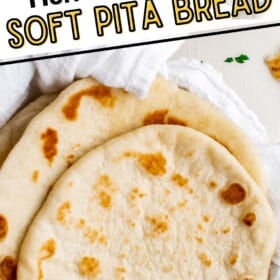
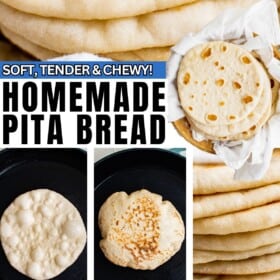
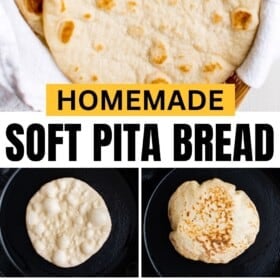
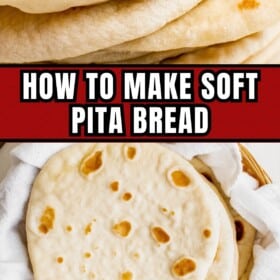
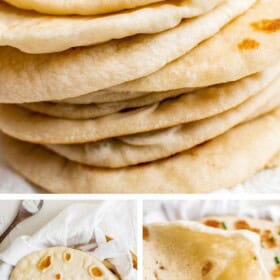
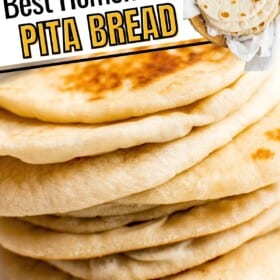
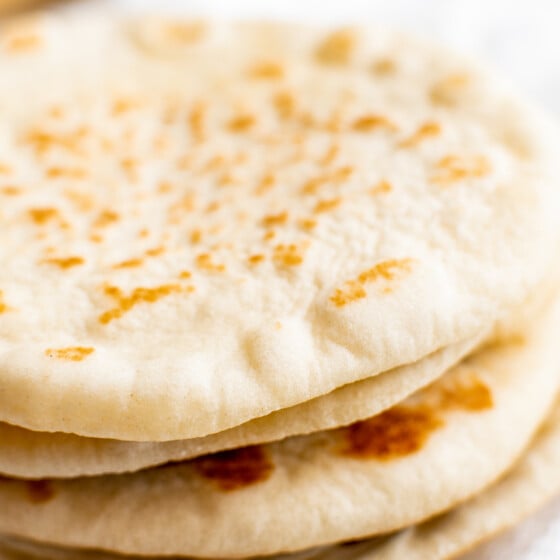
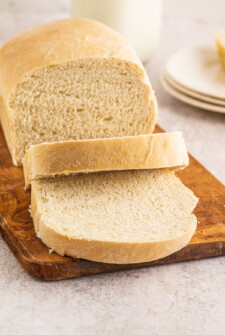
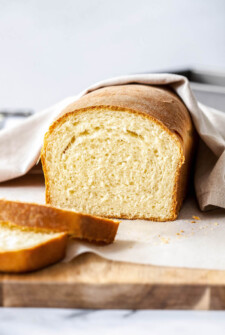
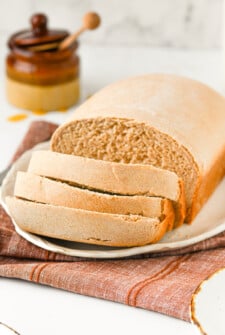
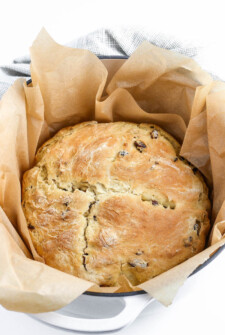
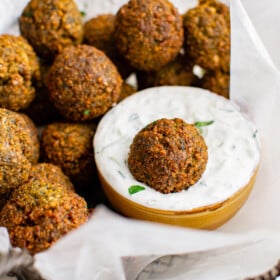
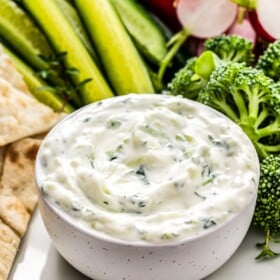
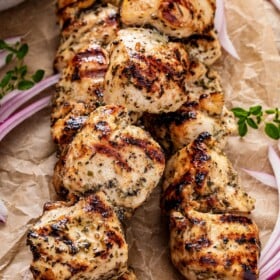


Great recipe! These turned out perfect!
The yield states 6-7 pitas but the instructions say divide into 10 pieces. Could you give an idea of the size differences if I were to divide into 6 vs 10 balls of dough? I have been searching for a pita recipe like the ones used at OPA restaurants. I know they are a “fast food” type restaurant so they may not be particularly authentic but I love how fluffy and chewy their pitas are compared to the drier pocket type pitas available in grocery stores.
Hi Shelley! Thank you for catching that, it should state 10 pitas and has been updated now to show the correct yield! I would do the 2 oz balls as directed, but you can make them larger if you prefer, they will work either way. These are definitely more moist than what you would get at the store! Hope this helps!
Hi Jessica, Thank you for your reply. I printed out the recipe as it was, then realized I needed to make a little more so I scaled it up to 10 and printed. Then I thought 5 cups of flour may make too much so I scaled it back down to maybe 8? I can’t remember, but it changed to 3 tablespoons of sugar and 4.5 cups of flour. I actually ended up making 12 pitas with that recipe. They were a decent size for us to stuff with your chicken slouvaki recipe. I also used your recipes for Greek seasoning, Greek salad dressing and Greek salad for a Greek themed birthday dinner for my son. Everything was great. The pita dough was beautiful to work with.
So glad to hear it worked out and you enjoyed it all! 🙂
I loved the taste however I was hoping you can help me trouble shoot why only one proofed up and created the pocket! The rest of them stayed flat.
Hi Kailea! Hmm, that is very strange! Where they cooked all at the same time? Or did some of the dough sit for a while? I assume it was all cooked at the same time, but I am not sure why only one would puff up. I wish I had a better answer!
Omg yummm. My 3 and 6 year old helped make them and also loved them! Thank you.
Delicious taste and easy to make. Thanks for the recipe!!
Just made this recipe and ummmmmm it’s amazing!!!! So so easy to make, I will be making another batch tomorrow 🙂
I replace the water with milk simply because I prefer it that way but absolutely love these. They’re amazing and it’s so simple
Can it be left to rise in the first step for longer than 1 hr? Thanks!
Hi Trish! It can be left a little longer, but dough that is left too long to rise will eventually be over-proofed, can potentially collapse and mess with the final texture. So 20-30 minutes more would probably be the longest it could go.
Thanks so much! I’m pretty new to making breads, so this is super helpful 🙂
Great recipe. So easy. They worked well for the vegan gyros I made with them. They were light and fluffy. Highly recommend this recipe.
Could the mix, knead, and rise be done in a breadmachine??
Hi Donna! I have not tried it in a bread machine (and don’t have one), but please let us all know how it works out if you try it!